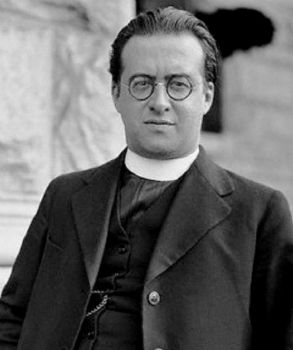ASTB03 Assignment 5
ASTB03 Assignment 5 Mark - 6110
 Georges Lemaître (July 1894 - June 1966) was an astronomer, physicist, and Catholic priest. At the age of 17, Georges began to study civil engineering at the University of Leuven. At this point, his studies were interrupted by World War 1, where Georges served as an artillery officer for the Belgian army. After the war, he switched his studies from civil engineering to physics and mathematics. After a few years of study, he received his doctorate in 1920 for a thesis on "Approximation of functions of several real variables". In 1923, Georges became a graduate student of astronomy at the University of Cambridge in England. He worked alongside Arthur Eddington, who triggered Georges interest in cosmology, and astronomy. Georges mathematical background of numerical analysis gave him a strong backbone for his studies in astronomy. Lemaître believed strongly in Einstein's theory of general relativity, and was one of the first to actively apply Einstein's theories to cosmology. In 1927, Georges discovered a series of solutions to Einstein's equations of relativity. The solutions implied that the Universe was not still, but expanding outwards. He described "A homogeneous Universe of constant mass and growing radius accounting for the radial velocity of extragalactic nebulae." He also theorized that the more distant an object in the Universe, the faster it would be moving away from us. This proportionality (more precisely described with the Hubble constant), with the work of Edward Hubble would later be verified and be known as Hubble's Law. Lemaître strongly believed in the idea of an expanding Universe because it explained the proportionality between the distance of a galaxy the redshift in the light it emits. In 1931, Georges first articulated his theory that all of the Universe had expanded from a single point. He called this point "the primeval atom", as well as "the cosmic egg". He explained that there was a single moment of creation, where this tiny point containing the entire Universe burst, and ever since the Universe has been expanding outwards from the creation point.
Georges Lemaître (July 1894 - June 1966) was an astronomer, physicist, and Catholic priest. At the age of 17, Georges began to study civil engineering at the University of Leuven. At this point, his studies were interrupted by World War 1, where Georges served as an artillery officer for the Belgian army. After the war, he switched his studies from civil engineering to physics and mathematics. After a few years of study, he received his doctorate in 1920 for a thesis on "Approximation of functions of several real variables". In 1923, Georges became a graduate student of astronomy at the University of Cambridge in England. He worked alongside Arthur Eddington, who triggered Georges interest in cosmology, and astronomy. Georges mathematical background of numerical analysis gave him a strong backbone for his studies in astronomy. Lemaître believed strongly in Einstein's theory of general relativity, and was one of the first to actively apply Einstein's theories to cosmology. In 1927, Georges discovered a series of solutions to Einstein's equations of relativity. The solutions implied that the Universe was not still, but expanding outwards. He described "A homogeneous Universe of constant mass and growing radius accounting for the radial velocity of extragalactic nebulae." He also theorized that the more distant an object in the Universe, the faster it would be moving away from us. This proportionality (more precisely described with the Hubble constant), with the work of Edward Hubble would later be verified and be known as Hubble's Law. Lemaître strongly believed in the idea of an expanding Universe because it explained the proportionality between the distance of a galaxy the redshift in the light it emits. In 1931, Georges first articulated his theory that all of the Universe had expanded from a single point. He called this point "the primeval atom", as well as "the cosmic egg". He explained that there was a single moment of creation, where this tiny point containing the entire Universe burst, and ever since the Universe has been expanding outwards from the creation point. 
 Alexander Friedmann (June 1888 - September 1925) was a Soviet cosmologist and mathematician. Independently from Lemaître, in 1922 Friedmann also came to the conclusion that the Universe was expanding. Through Einstein's theory of relativity, Friedmann's work supported both the "Big Bang" and "Steady State" models of the Universe. However, physical evidence today has made the Big Bang theory much more accepted. Einstein also initially believed that Friedmann's solutions to his general relativity equations were incorrect, but later conceded that they were indeed correct. Like Lemaître, Friedmann's belief that the Universe was expanding was verified by Hubble's observations in 1929.
Alexander Friedmann (June 1888 - September 1925) was a Soviet cosmologist and mathematician. Independently from Lemaître, in 1922 Friedmann also came to the conclusion that the Universe was expanding. Through Einstein's theory of relativity, Friedmann's work supported both the "Big Bang" and "Steady State" models of the Universe. However, physical evidence today has made the Big Bang theory much more accepted. Einstein also initially believed that Friedmann's solutions to his general relativity equations were incorrect, but later conceded that they were indeed correct. Like Lemaître, Friedmann's belief that the Universe was expanding was verified by Hubble's observations in 1929.Bibliography:
https://www.physicsoftheuniverse.com/scientists_lemaitre.html
https://www.physicsoftheuniverse.com/scientists_friedmann.html
https://www.britannica.com/biography/Georges-Lemaitre
https://en.wikipedia.org/wiki/Georges_Lema%C3%AEtre
https://en.wikipedia.org/wiki/Alexander_Friedmann
Comments
Post a Comment